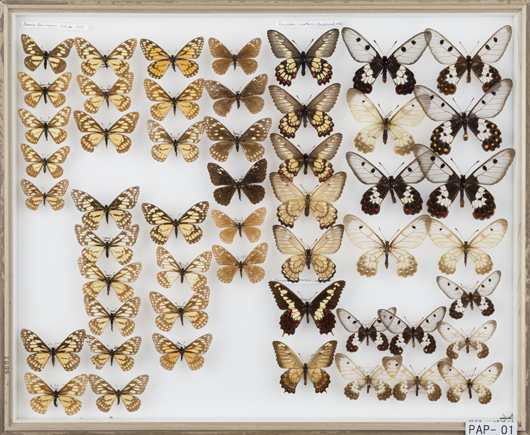- UMDB Top >
- Entomology >
- Introduction >
- Omoto Butterfly Collection 1
Keiichi Omoto Butterfly Collection. Part 1 Papilionidae: Baroniinae and Parnassiinae

Introduction
Dr. Keiichi Omoto (1933– ), who was born in Tokyo, is a famous lepidopterist who has dedicated himself to researching butterflies. He began a period of academia at the University of Tokyo in 1952, receiving a doctorate of science in 1972. Subsequently, he became a professor of the Faculty of Science, the University of Tokyo, going on to work as a professor at the International Research Center for Japanese Studies in 1993–99, then as a professor at St. Andrew’s University. He is currently a professor emeritus of the University of Tokyo and the International Research Center for Japanese Studies. His primary field is molecular anthropology, but he is also prominent as an entomologist, studying the systematics of butterflies, primarily Parnassiinae of the family Papilionidae. While studying in Germany in 1961-1964, he carried out butterfly research with Colin W. Wyatt in 1963 at the Hindu Kush mountains, Afghanistan, collecting very rare species such as Parnassius autocrator and Colias marcopolo. He is also known to be an accomplished player of shogi, Japanese chess.
His butterfly collection, which is comprised of roughly 27,000 specimens, contains many type specimens including nine holotypes originally described by himself such as the subspecies kushana of Colias marcopolo. Of particular interest are Parnassiinae of the Papilionidae, Apporia and Colias of the Pieridae, and Apaturinae and Satyrinae of the Nymphalidae from Eurasia, North America and Oceania. In 2013, this collection was kindly donated to the University Museum, the University of Tokyo.
The University Museum, The University of Tokyo, is currently data-basing the deposited insect collections to make available to the public as the University Museum Database (UMDB) project. The "Catalogue of the Keiichi Omoto Butterfly Collection" is included as part of this project, and it was decided to release the baroniine and parnassiine data of the collection on the website of the university museum since the data-basing of the butterfly part has been completed. The insect collection contains a total of 5,425 butterfly specimens arranged in 80 mid-sized specimen boxes.
This database not only contributes much to taxonomy and systematics, but also provides an inventory that underpins biodiversity conservation. For example, basic data on distribution is the foundation for spatial analysis of patterns in biogeography and changes in environmental issues such as global warming, deforestation and environmental destruction. We hope that by publishing this database, it will not only contribute to research of various scientific fields in Japan and abroad, but also promote to the public the importance of preserving and cataloging scientific specimens and creating museum collections.
Acknowledgments
We express our sincere thanks to Mr. N. Moffat for his critical readings of the manuscript.
